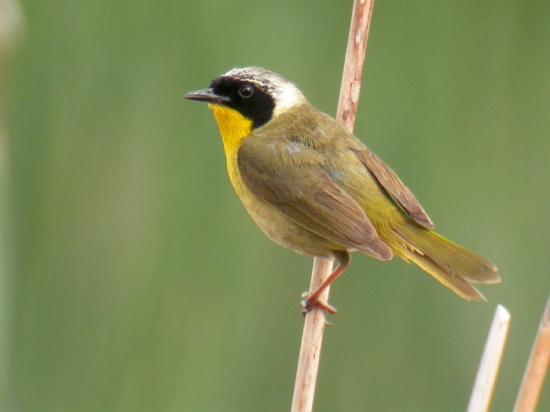| Line 1: | Line 1: | ||
| − | ;Geothlypis trichas | + | ;[[:Category:Geothlypis|Geothlypis]] trichas |
[[Image:Common_Yellowthroat.jpg|thumb|550px|right|Photo by Steve Messick]] | [[Image:Common_Yellowthroat.jpg|thumb|550px|right|Photo by Steve Messick]] | ||
==Description== | ==Description== | ||
| Line 37: | Line 37: | ||
==External Links== | ==External Links== | ||
{{GSearch|Geothlypis+trichas}} | {{GSearch|Geothlypis+trichas}} | ||
| − | [[Category:Birds]] | + | [[Category:Birds]][[Category:Geothlypis]] |
Revision as of 21:56, 17 August 2008
- Geothlypis trichas
Description
4 1/2-6" (11-15 cm). Olive-brown above, bright yellow on throat and upper breast. Male has bold black mask, bordered above with white. Females and young males lack face mask, but may be recognized by bright yellow throat and wren-like behavior.
Identification
Description 4 1/2-6" (11-15 cm). Olive-brown above, bright yellow on throat and upper breast. Male has bold black mask, bordered above with white. Females and young males lack face mask, but may be recognized by bright yellow throat and wren-like behavior.
Distribution
Breeds from Alaska, Ontario, and Newfoundland south throughout United States. Winters in southern states and in tropics. Accidental vagrant to Great Britain (5 records).
Taxonomy
Subspecies1
- G. t. arizela - breeds coastal pacific from southeastern Alaska south to central coastal California
- G. t. campicola - breeds from British Columbia east to western Ontario south to Idaho east to Nebraska
- G. t. chapalensis - breeds in northwest Mexico
- G. t. chryseola - breeds se. Arizona to s. New Mexico, w. Texas and nw. Mexico
- G. t. ignota - breeds in the Gulf Coast from eastern Louisiana east to whole state of Florida
- G. t. insperata - breeds in southern Texas (Rio Grande Valley south of Brownsville)
- G. t. melanops - breeds in central Mexico
- G. t. modesta - breeds in western Mexico
- G. t. occidentalis - breeds from central Washington south to Nevada east to western Kansas and New Mexico
- G. t. scirpicola - breeds in southern California, northern Baja California, southern Nevada, and western Arizona
- G. t. sinuosa - breeds in San Francisco bay region
- G. t. trichas - breeds throughout the east from western Ontario south to North Carolina and eastern Texas
- G. t. typhicolai - breeds from central eastern Mississippi east to coastal Carolinas and Georgia
- G. t. yukonicola - breeds in Yukon Territory and northern British Columbia
Hybridization occurred once with Mourning Warbler.
Habitat
Moist thickets and grassy marshes, almost anywhere where it is damp or with water.
Behaviour
Nesting 3-5 white eggs, with brown and black spots, in a loose mass of grass, sedge, and bark, lined with rootlets, hair, and fine grass, and concealed on or near the ground in a dense clump of weeds or grass.
Voice
Loud, fast witchity-witchity-witchity-witchity-wit or which-is-it, which-is-it, which-is-it. Call a sharp chip.
Discussion
A small bird with a yellow throat, skulking in the grass or weeds of a marshy spot, is almost certainly a Common Yellowthroat, whose cheerful song is well known. At the height of the breeding season, the males perform an attractive flight display, mounting into the air while uttering a jumble of high-pitched notes, then bouncing back into the grass while giving the usual song. To foil predators, parents drop down into the thick of the grasses or weeds, secretly approach their well-hidden nest, deliver the food, and depart by another route. The bird is the northernmost member of a group of yellowthroat species that occurs as far south as Argentina.
References
- Dunn, Jon; Garrett, Kimball. 1997. A Field Guide to Warblers of North America. Boston: Houghton Mifflin Company. ISBN 9780395783214
- Clements, James F. 2007. The Clements Checklist of Birds of the World. 6th ed., with updates to October 2007. Ithaca: Cornell University Press. ISBN 9780801445019




